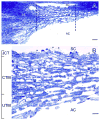Consensus recommendations for trabecular meshwork cell isolation, characterization and culture
- PMID: 29526795
- PMCID: PMC6042513
- DOI: 10.1016/j.exer.2018.03.001
Consensus recommendations for trabecular meshwork cell isolation, characterization and culture
Abstract
Cultured trabecular meshwork (TM) cells are a valuable model system to study the cellular mechanisms involved in the regulation of conventional outflow resistance and thus intraocular pressure; and their dysfunction resulting in ocular hypertension. In this review, we describe the standard procedures used for the isolation of TM cells from several animal species including humans, and the methods used to validate their identity. Having a set of standard practices for TM cells will increase the scientific rigor when used as a model, and enable other researchers to replicate and build upon previous findings.
Keywords: Aqueous humor dynamics; Conventional outflow; Glaucoma; Intraocular pressure; Ocular hypertension.
Copyright © 2018. Published by Elsevier Ltd.
Figures




References
-
- Acott TS, Samples JR, Bradley JM, Bacon DR, Bylsma SS, Van Buskirk EM. Trabecular repopulation by anterior trabecular meshwork cells after laser trabeculoplasty. Am J Ophthalmol. 1989;107:1–6. - PubMed
-
- Alvarado J, Murphy C, Juster R. Trabecular meshwork cellularity in primary open-angle glaucoma and nonglaucomatous normals. Ophthalmology. 1984;91:564–579. - PubMed
-
- Alvarado J, Murphy C, Polansky J, Juster R. Age-related changes in trabecular meshwork cellularity. Invest Ophthalmol Vis Sci. 1981;21:714–727. - PubMed
-
- Begley CG, Yue BY, Hendricks RL. Murine trabecular meshwork cells in tissue culture. Curr Eye Res. 1991;10:1015–1030. - PubMed
Publication types
MeSH terms
Substances
Grants and funding
- I01 RX001163/RX/RRD VA/United States
- R01 EY026935/EY/NEI NIH HHS/United States
- R01 EY026048/EY/NEI NIH HHS/United States
- R01 EY017006/EY/NEI NIH HHS/United States
- P30 CA086862/CA/NCI NIH HHS/United States
- R01 EY021205/EY/NEI NIH HHS/United States
- K99 EY022077/EY/NEI NIH HHS/United States
- R01 EY011906/EY/NEI NIH HHS/United States
- R01 GM100909/GM/NIGMS NIH HHS/United States
- R01 EY027733/EY/NEI NIH HHS/United States
- R01 EY026220/EY/NEI NIH HHS/United States
- R00 EY022077/EY/NEI NIH HHS/United States
- R01 EY022634/EY/NEI NIH HHS/United States
- R21 EY028671/EY/NEI NIH HHS/United States
- P30 EY005722/EY/NEI NIH HHS/United States
- I01 BX003938/BX/BLRD VA/United States
- R01 EY026009/EY/NEI NIH HHS/United States
- P30 EY016665/EY/NEI NIH HHS/United States
- R01 EY025643/EY/NEI NIH HHS/United States
- R01 EY026885/EY/NEI NIH HHS/United States
- P30 EY000331/EY/NEI NIH HHS/United States
- R01 EY019643/EY/NEI NIH HHS/United States
- P30 EY021725/EY/NEI NIH HHS/United States
- K08 EY024674/EY/NEI NIH HHS/United States
- I50 RX003002/RX/RRD VA/United States
- R01 EY026177/EY/NEI NIH HHS/United States
- R01 EY026529/EY/NEI NIH HHS/United States
- R21 EY027079/EY/NEI NIH HHS/United States
LinkOut - more resources
Full Text Sources
Other Literature Sources

